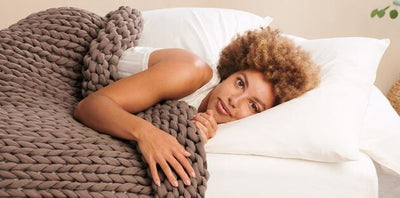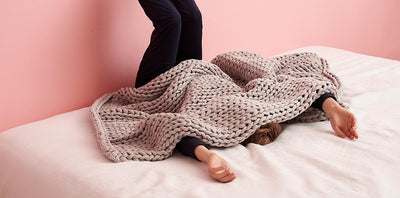The A to Z Guide on the Best Pillows For Lower Back Pain
The best pillow for lower back pain is one that supports the natural curve of your spine, usually by keeping your knees slightly bent while on your back or your side. Body pillows are great for both purposes and other pillows like bolsters and lumbar pillows can go under the lower back for support.

Bearassentials
Back pain is often caused by disc degeneration or herniation. This can lead to lower-back pain.
Keeping the legs bent is one of the best ways to prevent lower back pain, and body and bolster pillows can help with this.
The right head pillow can also help to ensure your upper-spine posture is in check
Did you know?
Everybody’s lumbar discs wear down with age. It’s completely normal, and it’s one reason why disc herniation is more common in the elderly. The more wear and tear, the easier they slip.
Dealing with back pain from a nagging injury? Finding that rolling out of bed each morning is one of the hardest parts of your day?
Whether it’s old or new, acute or chronic, or falls anywhere from a 1 to a 10 on the pain scale, back pain can make getting a good night’s rest feel impossible. Thankfully, some of the best pillows for lower back pain can make it a little easier.
From body pillows to bolsters, cushions can keep the back supported and relatively pain-free. Depending on your specific issue, they may help you too.
How Common Is Back Pain?
If you’re struggling with back pain, you’re not alone. 8.2% of Americans are living with chronic severe back pain. This may mean that they’re waking up to pain that prevents them from fully living their lives every morning.
Others are dealing with acute pain, meaning pain from an injury or medical procedure that generally only lasts for a short time. But even this can become chronic pain over time.
The amount of people with back conditions is increasing, too, largely thanks to the amount of desk work we tend to do in this day and age. It turns out that slouching in a chair while staring at a screen can easily lead to posture-related back pain.
Of course, there are many other ways to injure your lower back.

Types of Back Pain
When it comes to lower back pain, people usually experience issues with one of two areas: The lumbar spine and the muscles that are connected to that area.
A lot of back pain comes either from trauma to that area or from muscle imbalances that are often caused by poor posture.
Nerve-Generated Pain
Between each vertebrae in the spine are squishy disks that act as shock absorbers, protecting each little bone from the impact of things like running and jumping. These disks are supposed to be the same width as the vertebrae around them, but sometimes they protrude, usually because of an injury or poor exercise form.
When this happens they can press on the nearby sciatic nerve, causing pain and sometimes numbness that starts in the lower back and moves as far as the feet. It also tends to lead to reduced mobility, especially in the early morning after waking up.
Bone Issues
Aside from disks, the vertebrae in the spine can take a lot of damage too. Sometimes this can lead to fractures, and sometimes there can also be long-lasting problems like arthritis and spondylosis. These can lead to chronic pain that’s often managed with pain meds.
Soft Tissue Damage
Aside from disks, bones, and nerves, the lower back is also filled with a complex network of ligaments, muscles, and tendons. Injury to any of these areas can cause as much pain as herniated discs and sciatica.
It’s also one of the most common ways to hurt your back. Sometimes all it takes is a sneeze that you’re not ready for or lifting a heavier-than-expected box.
Possible Causes Of Back Pain From Sleeping
If you’re waking up with back pain in the morning, the cause doesn’t need to be anything as shocking as a herniated disk or sprained back. Often the discomfort is a product of remaining in the same position for a long time – something most people do when they sleep.
Since the muscles and bones in the back like to maintain a certain posture, that extended time in bed can cause problems if unsupported. Here are some of the common causes of back pain from sleeping:
- Mattress that doesn’t give you the right support. Studies show that medium-firm mattresses are some of the best for back pain.
- Poor sleeping posture. Side sleeping is great for avoiding back pain and using pillows to support the knees can help when sleeping face-up.
- Pregnancy. A pregnant belly can cause all kinds of back trouble, but pregnancy pillows can help with that too.
- Medical issues like degenerative disc disorder and fibromyalgia, among others.
There are many other conditions that can lead to back pain from sleeping, and there are also plenty of ways to support yourself to lighten the load.
What Type Of Pillow Should I Use For Lower Back Pain?
Everybody has to sleep, and some people need a little more support in bed than others. From big to small, here are some of the best pillows for lower back pain, all with different benefits depending on your sleeping position.
Lumbar Pillow
Used as a blanket term for pillows that fit in the small of your back, lumbar pillows come in many shapes and sizes. One of the most common shapes is a half-cylinder that can slide right under the small of your back. This helps provide support to the spine’s natural curve.
Bolster Pillow
Another pillow that could be considered a type of lumbar pillow is the bolster pillow. It’s a short, full cylinder that works well as a decorative or lower back-supporting pillow. Our Cuddling bolster pillow is made of naturally-sourced Melofoam, making it supple while also being able to support the back.
Body Pillow
The swiss army knife of bedding options, the body pillow also happens to be one of the best pillows for lower back pain. Back sleepers can slip it under their knees to ease pressure on their spine, side sleepers can hug and straddle it to open up the hips and shoulders, and even stomach sleepers can slide it under their bellies for relief.
Our Cuddler’s ergonomic design makes it ideal for use in different situations. So, if you like to flop around from your back to your side it can help you there, too.
Different Types of Head Pillow
This may come as a surprise, but head pillows can make a big difference to your lower back. It’s all connected, after all. If your head is pushed too far forward while sleeping on your back it lifts the cervical spine and can subtly impact the lumbar spine. That’s why it’s important to have a small-medium sized pillow that maintains a neutral position.
If you’re a side sleeper, you’ll want something a little thicker to prevent the head from drooping toward the shoulder. The goal is to keep the head and lower back in a straight line.
Wedge Pillows
This one’s for all the pregnant people out there. Studies have shown that special wedge-shaped pillows are among the best pregnancy pillows for lower back pain. Just rest the little fella on the pillow while on your side and start to feel the weight get lighter.

What To Consider When Purchasing A Pillow For Back Pain
Okay, so you’re ready to take the plunge into the world of better pillows. What now?
If you’re looking to set your back up for success, the first thing you’ll want to consider is the severity of your situation. Is your back pain mild or is it severe? Is it a short-term problem or is it more a long-term problem related to posture?
For acute pain from recent injuries, you may not need to buy a new pillow at all. Oftentimes a normal head pillow or couch cushion under or between the knees can do the trick until your back is back to normal.
For chronic pain you may want to look into a head pillow that adequately supports your neck. After that, consider the following:
- A body pillow that can be used for back sleeping and side sleeping.
- A bolster pillow that works as a support while awake at your desk or in the car.
- A lumbar support pillow that’s not too large so that it can fit under the lower back while you sleep.
What Pillow Materials Are Best For Back Pain?
The materials of the pillow are every bit as important as the shape. After all, the goal is to have a pillow that acts as your durable foundation, whether during sleep or daytime.
Latex
One of the best pillow materials for lower back pain is latex. It’s firm yet moldable, and it’s also one of the most long-lasting pillow materials out there. On top of that, our Melofoam latex material at Bearaby is fully biodegradable, so you can lighten the load on mother nature and your back at the same time.
Memory Foam
Another pillow filing option for lower back pain is memory foam. It lasts relatively long and takes the shape of the body which can be great for back pain when used in mattresses or head pillows. However, this material can be a bit soft when used as a leg support.
Feather and Down
For back sleepers, feather and down pillows can work wonders as they’re fairly shapeable. Just bunch up some of the feathers in one end and you have a great neck support that keeps your standing posture in place. Again, this doesn’t work as well with body pillows as the feathers tend to gather in certain spots and compress as your body weighs down.
What Is The Best Pillow Positioning For Back Pain?
Decided on the perfect pillow and just need to know how to use it? Well, the best pillow positioning for back pain depends on what kind of sleeper you are first. After all, you can force yourself to sleep in one position at the start of the night, but your body may still naturally fall into a different one later on.
For back sleepers, the best way to relieve back pain is usually with the knees bent slightly to reduce the load on the spine. One of the easiest ways to maintain this position is with a pillow under the knees.
If you’re a side sleeper, you’ll likely see the best results if you keep the pillow between your knees. Again, your legs should be slightly bent to keep the spine in good shape.
Back sleepers, unfortunately, have it a little harder. The position puts the most stress on the spine, but if you have to sleep that way, slide a thin pillow under the belly
Strategies for Alleviating Back Pain
Aside from changing the way you sleep, there are plenty of ways to tackle that aching back. Seeing a doctor or physiotherapist to find out exactly what the problem is and getting advice on how to improve from there should be at the top of your list.
Oftentimes these medical professionals will suggest avoiding certain things right off the bat. Here are a few
- Sitting or standing with poor posture for extended periods. This is an area where it’s especially important to get outside advice as you may not be aware of your issues.
- Frequent, repetitive movements that put strain on the lower back.
- Lifting heavy objects with poor form.
On top of the don’t-do’s there are things that you may want to add to your daily repertoire. This all depends on the type of problem you’re dealing with and the severity of the issue. Unfortunately there’s no one-size-fits-all solution for lower back pain, but here are some things you can dip your toes in:
- Core strengthening exercises such as the “McGill big three”: Curl-ups, side planks, and bird-dogs. Here’s a good video guide to the exercises.
- Mobility exercises such as cobras, cat-camels, or full yoga routines.
- Use of tools like bolster or lumbar pillows to support your back while in a chair or sleeping.
One of the most important rules of rehab is to avoid doing things that are painful, so above all, don’t do anything that makes the situation worse. Other than that, play around with different solutions until you find something that helps.
FAQ's
Got more questions about the best pillows for lower back pain? Here are some of the common ones and their answers.
Can a good pillow help lower back pain?
Yes, a good pillow can help lower back pain in many ways. A head pillow that keeps your neck in a neutral position throughout the night positively affects the entire spinal chain down to the lower back
Support pillows can also be hugely beneficial depending on how you sleep. For example, body pillows help keep the hips open while sleeping on your side. Lumbar and bolster pillows can also support the lower back when sleeping face-up.
What is the best pillow height for lower back pain?
The best pillow height for lower back pain is medium-high for side sleepers, medium-low for back sleepers, and low or none for stomach sleepers. When sleeping on your side, your pillow should be high enough to keep your spine in a straight line. Back sleepers should aim to have their neutral standing neck posture supported.
If you’re a stomach sleeper, no pillow at all may be the best choice as any added height can put stress on the cervical spine.
How should I sleep if my lower back hurts?
If your lower back hurts, sleeping on your back with your legs propped up under a body pillow can relieve pressure on the area. Bending your knees in this way puts the lumbar spine in a more neutral position.
Side sleeping may be even better for lower back pain as long as you bend your knees slightly and fix a pillow between them to open the hips.
If you sleep on your stomach, try a thin pillow under the belly.
What is the most important consideration when choosing a pillow for back pain?
The most important consideration when choosing a pillow for back pain is your preferred sleeping style. Side sleepers need a pillow that’s large and firm enough to keep the head aligned with the spine. Back sleepers should try something medium-sized that supports the neck. Stomach sleepers should look for something even thinner.
The pillow’s job is to keep the cervical spine in a neutral, non-load-bearing position throughout the night, so shop based on your sleeping patterns.
What is the worst pillow type for back pain?
The worst pillow type for back pain is one that doesn’t maintain its shape and firmness throughout the night. For head pillows this might include polyester fiberfill pillows, feather pillows, and possibly cotton as these pillows tend to flatten and clump up in odd places.
The pillow’s main job is to be a support for your spine throughout the night, so if it gets flat easily that could be one reason your back troubles aren’t improving.
Conclusion
The best pillow for back pain depends on your preferred sleeping position. Head pillows should be bigger if you sleep on your side and slightly smaller if you prefer laying on your back.
Support pillows like our Cuddler body pillow or Cuddling bolster pillow can also help support the legs, hips, and back. Just be sure to pick one that’s firm enough to support your legs and soon you may be waving goodbye to that back pain.






